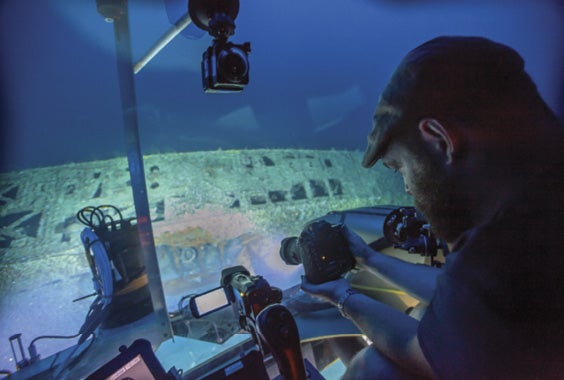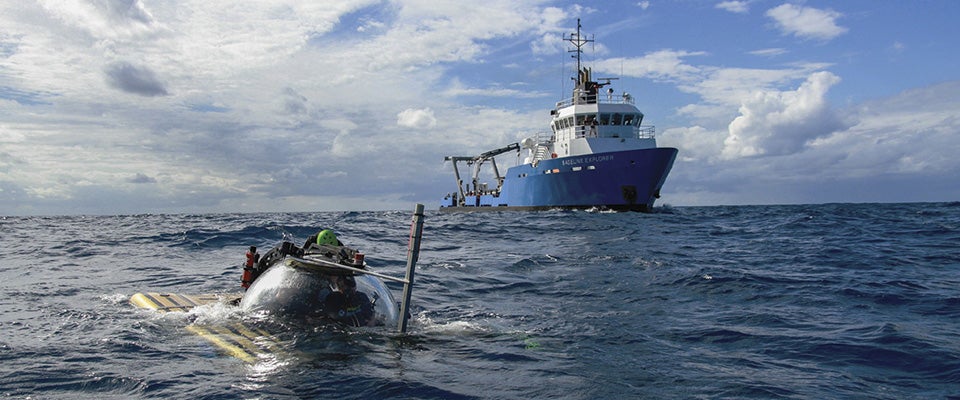Operation Discovery

NOAA archaeologist Joe Hoyt documents the damage to U-576.
From diving on undersea battle fields to homeless veterans, military-related research is an expanding enterprise at East Carolina University.
And with more than $7 million in research funding from the Department of Defense since 2010—and more than that from other sources—administrators and faculty members see the field as a growth opportunity.
“Growing our defense relationship in terms of research is going to be very important,” says ECU Provost Ron Mitchelson, especially as the university aims at reaching $100 million in external research and contract funding.
Diving back in time
On July 15, 1942, the German U-boat U-576 fired its torpedoes at a convoy of ships off Cape Hatteras, sinking the freighter Bluefields and damaging two other vessels. Retaliation was swift, as another merchant ship in the convoy fired on the U-boat, and air support was called in, dropping depth charges and ultimately sinking the submarine.
That was the last anyone saw of either vessel until 2014, when the National Oceanic and Atmospheric Administration located the wrecks using high-resolution sonar during an autonomous underwater survey of the area. Thirty-five miles off shore in about 700 feet of water, the two vessels lie on the bottom just 240 yards apart.
In August, researchers visited the underwater battle field for the first time in 74 years using two manned submersibles launched from the 150-foot research vessel Baseline Explorer. Researchers from the University of North Carolina Coastal Studies Institute, in partnership with NOAA’s Monitor National Marine Sanctuary, the Bureau of Ocean Energy Management and Project Baseline, became the first people to lay eyes on the vessels since the day they sank.
ECU is the administrative campus for the CSI.
The manned submersibles put the scientists in the environment they’re studying in a way that remotely operated vehicles can’t do, says John McCord CSI, associate director of education and outreach. “With that firsthand view, there might be things that you can infer that you couldn’t through a screen.”
The goal of the project is to study and document the wrecks to learn more about what happened during the battle, as well as the natural habitats surrounding the shipwrecks, according to Joe Hoyt, Monitor National Marine Sanctuary archaeologist and chief scientist for the expedition.
The two crew members—one pilot and one scientist—aboard each sub were able to see several details that provide new information about the wrecks and the battle. The dive planes of U-576 are pitched as if it were trying to surface.
“All three of the hatches were locked down tight,” says Hoyt, “so that tells you those 45 men are still inside that vessel.”
The sailors aboard the Bluefields were rescued by other vessels in the convoy.
Externally, the U-boat is largely intact, other than the wooden decks, which have rotted away. “Most of it is encrusted with marine life, but it is in good shape relative to other U-boats off the N.C. coast,” McCord says. “On the Bluefields, there is an enormous hole the size of a small house where the torpedo impacted.”
Photographic and videographic footage, as well as laser scanning, will be used by CSI to create detailed 3-D models of the two wrecks. These models will be useful for both research and outreach, McCord says.
The photogrammetric model provides a realistic surface image of the model, while the laser data creates an extremely accurate record of the wreck’s dimensions.
Unfortunately, tropical storm activity in the Atlantic cut the project short, limiting the amount of data that could be collected. McCord says he hopes to return to the site next year to finish the project.
The expedition was part of NOAA’s effort to document nationally significant shipwrecks in the Graveyard of the Atlantic. In addition to ECU, member institutions of the CSI are Elizabeth City State University, N.C. State, UNC-Chapel Hill and UNC- Wilmington.
Farther afield in the North Pacific, ECU history faculty member Jennifer McKinnon has worked in the Mariana Islands for nearly a decade on underwater WWII sites and has been the principal investigator on the development of the diving WWII Maritime Heritage Trail: Battle of Saipan.
Allied and Japanese forces collided at Saipan in the Northern Marianas Islands in June and July of 1944. Over three weeks of fighting, the U.S. 2nd Marine Division (now based at Camp Lejuene, North Carolina), 4th Marine Division and the Army’s 27th Infantry Division defeated the 43rd infantry division of the Japanese Army. As a result, U.S. forces were able to build air bases on the island and others nearby that put mainland Japan within striking distance of B-29 bombers.
Today, the coastal waters of Saipan are tranquil, but just beneath the surface are the remains of numerous American and Japanese tanks, ships, aircraft and landing craft.
McKinnon says students who explore these undersea battle fields have eye-opening experiences.

Read about the underwater sites of the Battle of Saipan at www.pacificmaritimeheritagetrail.com or watch online at
www.youtube.com/watch?v=ktXdO4OHvcg
“They talk about how they felt, how much destruction you can see underwater, how the plane was ripped apart and scattered everywhere,” she says. “It’s ‘wow, this is intense.’”
Students also find all is not yet known about World War II. “They think they’re just recording the site, but they start to discover things that aren’t in the written record,” she says.
For example, she says, one of her students found bows on Marine landing craft were thicker than they were supposed to be. Further exploration uncovered that Marines welded boilerplate onto the craft so they could better handle running over coral reefs. He kept looking and found other field modifications.
Students are also able to make connections in the small world of maritime archaeology and turn those into jobs. Jim Pruitt ’15 is now the archaeologist for the historic preservation office in Saipan. Melissa Price ’15, who dove on a similar exploration at Midway in the Pacific, is now an archaeologist in Florida.
McKinnon’s team also studied caves used as shelter by the civilian and Indigenous Chamorro and Carolinian community during the war.
Her work was supported by more than $213,000 in grant funding. And her team has received another grant of $64,579 to head back to the region and focus on the Battle of Tinian. She’s also part of a NOAA- funded team studying the Battle of Midway.
She’s submitted a proposal for a study-abroad course next summer in Saipan aimed at student veterans that will look at not only the Battle of Saipan but also the Spanish-Chamorro Wars of the 17th century, the European discovery and colonization of the islands.

U.S. Marine Corps veteran and physician assistant studies student Foster Hunt volunteered with Operation Re-entry North Carolina as his service-learning project.
Helping veterans
Another example is Operation Re-entry North Carolina. A multiyear, $4 million grant-funded project, ORNC supports military service personnel, veterans and their families by bringing together researchers and projects that focus on the resilience, rehabilitation and reintegration of returning servicemen and servicewomen.
The original funding ended Sept. 30, but many projects will continue with additional grant funding.
“Where we’re at is a juncture,” says Ted Morris, associate vice chancellor for the Office of Innovation and Economic Development. “Department of Defense funding has come to an end, but we have an effective umbrella to keep going.”
A focal point of Operation Re-entry is a van that ECU faculty, staff and students use to make thrice-weekly trips to eastern North Carolina counties to help nearly 300 veterans who are homeless or at risk of homelessness. It’s also a mobile clinic with technology to provide medical, psychiatric and behavioral health services to veterans and their families in communities where they live. The clinic is funded by an $828,956 grant from the federal Substance Abuse and Mental Health Services

The latest step in the project is leasing 25 smartphones to veterans to help them make connections to improve their lives.
A total of 50 participants will get at least three months use of a phone, and the main emphasis will be a behavioral health app that will encourage at least weekly contact with counselors, says Paul Toriello, chair of the addictions and rehabilitation studies in the College of Allied Health Sciences.
Master’s and doctoral students in ECU rehabilitation counseling and medical family therapy programs have built relationships with veterans across eastern North Carolina. Most project participants are male, in their 50s and 60s and veterans of the Vietnam War or the first Gulf War. Many are homeless and combating drug abuse and mental health issues, and almost all are unemployed, Toriello says.
“All have been willing to engage with us,” he says. “I praise my team—that was our goal—to reach out and talk with people where they’re at.”
The team made contacts with area Veterans Affairs offices and other organizations such as local soup kitchens and employment offices. They also “cold called” employers by county and shared job openings with participants.
The mobile clinic is among a dozen projects under the umbrella of Operation Re-entry North Carolina. Others have ranged from biofeedback and virtual reality, balance and hearing analysis, and social and personal resiliency to new tests for blast-induced traumatic brain injuries and life skills and workforce development for service members.
“As long as ECU has the investigators to put in the proposals and ask the questions, ECU will have access with us being in the middle of the third most populous military area in the nation,” said James R. Menke, retired Navy master chief petty officer and military research liaison and project manager for ORNC.
Uncovering clues to an illness
In addition to research into battle field maladies such as traumatic brain injury and post-traumatic stress disorder, ECU experts have also studied Gulf War illness, the oft-misunderstood collection of symptoms experienced by as many as 250,000 veterans of the 1991 conflict.
Dr. William Meggs, a professor of emergency medicine at the Brody School of Medicine and a board-certified medical toxicologist, studied veterans from the Carolinas, Virginia and other states as part of the four-year, $1.1 million study funded by the federal Department of Defense. The results of the study were published earlier this year in the journal Cortex.
Researchers concluded that not only did pesticides contribute to the illness, but also that pyridostigmine bromide-prophylactic pills intended to protect troops against the effects of possible nerve gas – was “causally associated with GWI and the neurological dysfunction in Gulf War veterans.”
The research team also cites studies showing a link between veterans’ neurological problems and exposure to the nerve-gas agents sarin and cyclosarin, as well as to oil well fire emissions.
The researchers have been studying the health of troops deployed in the Gulf War for more than 20 years to determine why so many of them suffer from a multi-system disorder characterized by fatigue, joint and muscle pain, headaches, concentration and memory problems, gastrointestinal distress and skin rashes.
Effective treatments for the illness have been elusive, but a recent treatment research effort has begun to produce promising leads. Meggs, who has received two research grants from the Department of Defense to study treatments, presented findings at an international congress in London in June and is preparing the work for publication.
“We found that some veterans with Gulf War illness were helped with a therapy called low- dose naltrexone (an anti-inflammatory agent), but others got no benefit,” Meggs says. He’s applying for further funding to see if other doses may help more veterans and to determine why some are helped and others aren’t.
